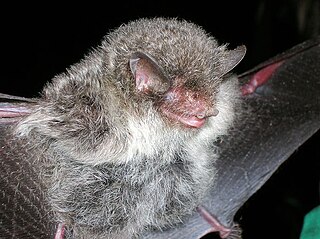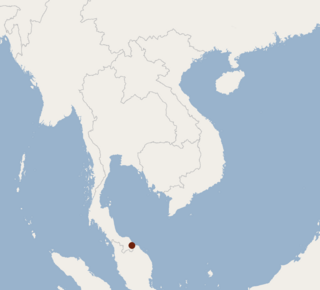 W
WThe Murininae are a subfamily of bats in the family Vespertilionidae. They include the tube-nosed bats and hairy-winged bats in the genera Murina, Harpiola, and Harpiocephalus.
 W
WThe ashy-gray tube-nosed bat is a species in the vesper bat family Vespertilionidae, found in southern Asia, including Pakistan, northern India, Burma, Thailand, Laos, and Vietnam. They have tube-shaped nostrils which assist them with their feeding.
 W
WThe Bala tube-nosed bat is a critically endangered species of bat found in Thailand.
 W
WBeelzebub's tube-nosed bat, also Beelzebub bat or demon bat, is a species in the vesper bat family Vespertilionidae, found in the Greater Mekong region of Southeast Asia, specifically the Quảng Trị and Gia Lai provinces of Vietnam. They have tube-shaped nostrils which assist them with their feeding.
 W
WThe bronze tube-nosed bat is a species of vesper bat in the family Vespertilionidae. It is found only in Malaysia.
 W
WThe Mekong bat, also known as Elery's tube-nosed nat, is a species of common bats first discovered in a forest of northern Vietnam.
 W
WThe flute-nosed bat is a vespertilionid bat with an unusually shaped nose, the tubular nostrils facing outward from the end of the muzzle. They occur in the north of the Australian state of Queensland, in Indonesia, and on Papua New Guinea.
 W
WThe gilded tube-nosed bat is a species of vesper bat in the family Vespertilionidae.
 W
WThe greater tube-nosed bat is a species of bat. An adult greater tube-nosed bat has a body length of 4.2-5.7 cm, a tail length of 3.6-4.1 cm, and a wing length of 3.7-4.4 cm. The species is found in India, Mongolia, China, and Korea.
 W
WHarrison's tube-nosed bat is a species of vesper bats (Vespertilionidae). Within the genus Murina, it belongs to the so-called 'cyclotis-group'.
 W
WHilgendorf's tube-nosed bat is a species of vesper bat in the family Vespertilionidae. In Japan they are called 'tengu komori', after the mythical creature called the Tengu. It was formerly thought to be a subspecies of Murina leucogaster, but is now known to be a distinct species.
 W
WThe lesser hairy-winged bat is a species of vesper bat in the family Vespertilionidae. It can be found in India, Indonesia, the Philippines, and Taiwan. They are known to eat various species of beetles. It is the only species in the genus Harpiocephalus.
 W
WMurina is a genus of vesper bats.
 W
WPeters's tube-nosed bat is a species of vesper bat in the family Vespertilionidae, found in the Indian Subcontinent, mainly in the Western Himalayas. They have tube-shaped nostrils which assist them with their feeding. They are brown with white-yellow and underparts and have specks of orange around their neck. While they are roosting, their fur, which seems to appear as a dead plant, camouflages them from predators. They are 3.3-6.0 cm in length and have round heads, large eyes and soft fur. This bat is found in India. They are endangered due to clearing of the rain forests in which they live in and are not protected by the World Conservation Union. They feed on rain forest fruit and blossoms.
 W
WThe round-eared tube-nosed bat, is a species of bat in the family Vespertilionidae from Central and Southeast Asia.
 W
WThe Ussuri tube-nosed bat is a species of vesper bat in the family Vespertilionidae. It is threatened by habitat loss. It is the only species of bat that hibernates in snowbanks.
 W
WWalston's tube-nosed bat is a species in the vesper bat family Vespertilionidae, found in the Greater Mekong region of Southeast Asia, specifically the Đắk Lắk Province of Vietnam and the Koh Kong and Ratanakiri provinces of Cambodia. This species was discovered in northeastern Cambodia in the Van Sai Protected Forest. They have tube-shaped nostrils which assist them with their feeding.